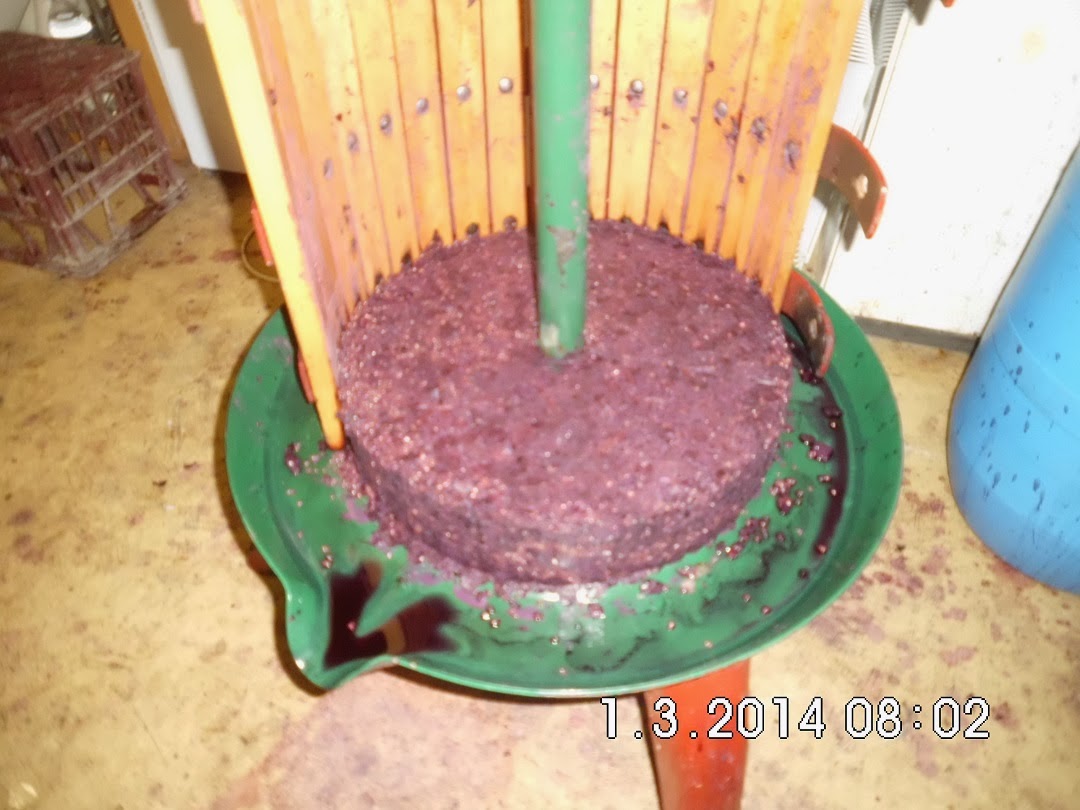Shiraz went first. Barely 35 kilograms
producing a little over 19 litres after 4 litres was drained for Rose
before fermentation. The demijohns had both American Oak and French
Oak added in a 50/50 mix equaling 6 grams per litre.
Leaving the Shiraz pressing in place
the Merlot was tipped in over the top. Starting with only 30
kilograms and having already taken out two litres the result was just
over 17 litres. It received the same Oak treatment as the Shiraz.
Finally the Tempranillo. Only 21
kilograms yielded just over 12 litres after the earlier 2 litre Rose
siphoning. Identical Oak treatment for it as well.
The Merlot was a much juicier grape
providing a better yield while the Tempranillo benefited from being
the last variety pressed. Just before it was added the previous grape
Marc was broken up which would have added a little more liquid and of
course being the last pressing of the day it received a very solid
pressing.
 |
| After pressing 70 kilograms of grapes there is very little marc remaining |
 |
| Our forest of air locked demijohns. |
Filling demijohns always starts with some calculations to estimate which is the largest sized demijohn that can be easily filled then progressively smaller containers are utilized right down to even a 175 ml bottle which can be used for topping up. The Oak chips that were added eventually absorb water and sink leaving a larger than desired air pocket which needs to be filled as soon as possible to prevent oxidisation of the wine.
 |
Pressing is an interesting process. At
first you jiggle the ratchet handle just finger tip lightly to allow
time for the juice to escape then gradually over a couple or more
hours additional pressure is required. It is important not to rush
the process otherwise juice may become trapped in pockets. Gradually
over time a lot of force is required to increase pressure. Eventually
almost no juice results even after letting it sit for a few hours and
the pressure gets to point that it cannot be increased.
There are periods where the press can
be left alone while juice continues to drain. This is the ideal time
to carry on with other cellar tasks such as topping up containers or
racking some that have gross lees thick in the base of the demijohn.
There is a never ending job of washing out containers and cleaning.
Originally the cleaning was done in the
laundry and there was a significant amount of running backwards and
forwards dripping water everywhere. Now, having a laundry tub and
double sinks in the Cave along with hot and cold rain water is such a
great benefit.
From about this time forward planning commences for the 2015 vintage. Notes are made as to further experiments or changes to techniques. Once we have had a chance to try the finished wines in a few months further refining of methods will be noted. We also look at our stores of yeasts etc to see if anything needs replenishing.
And no we will not purchase any more demijohns otherwise the pressure will be there to make more wine.

No comments:
Post a Comment